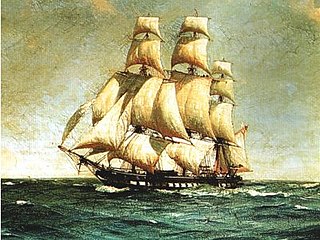
The Océan-class ships of the line were a series of 118-gun three-decker ships of the line of the French Navy, designed by engineer Jacques-Noël Sané. Fifteen were completed from 1788 on, with the last one entering service in 1854; a sixteenth was never completed, and four more were never laid down.

The Minerva-class sailing frigates were a series of four ships built to a 1778 design by Sir Edward Hunt, which served in the Royal Navy during the latter decades of the eighteenth century.
In 1794, three 64-gun third-rate ships were cut down to 44-gun fifth-rate frigates with a primary armament of 24-pounder guns, in a process known as razeeing. This was in response to rumours then circulating of very large French frigates supposed to be under construction. By Admiralty Order of 11 August 1794, two 64-gun ships of the Intrepid class – Anson and Magnanime – were to be cut down by one deck level. By a subsequent Admiralty Order of 8 September 1794, a third 64-gun ship – the Indefatigable of the Ardent class – which had been launched but never commissioned in 1784, was similarly to be cut down.

The Coventry-class frigates were 28-gun sixth rate frigates of the Royal Navy, principally in service during the Seven Years' War and the American Revolutionary War. They were designed in 1756 by Britain's Surveyor of the Navy, Sir Thomas Slade, and were largely modeled on HMS Tartar, which was regarded as an exemplar among small frigates due to its speed and maneuverability. The 1750s were a period of considerable experimentation in ship design, and Slade authorized individual builders to make "such alterations withinboard as may be judged necessary" in final construction.

The Dublin-class ships of the line were a class of seven 74-gun third rates, designed for the Royal Navy by Sir Thomas Slade.

The Intrepid-class ships of the line were a class of fifteen 64-gun third rates, designed for the Royal Navy by Sir John Williams. His design, approved on 18 December 1765, was slightly smaller than Sir Thomas Slade's contemporary Worcester-class design of the same year, against which it was evaluated competitively. Following the prototype, four more ships were ordered in 1767–69, and a further ten between 1771 and 1779.

The Magicienne class was a class of twelve fifth rate 32-gun frigates of the French Navy, each with a main battery of 26 x 12-pounder long guns, and with 6 x 6-pounder guns on the quarterdeck and forecastle. They were designed by Joseph-Marie-Blaise Coulomb.

The Pallas-class frigates were a series of three frigates built to a 1791 design by John Henslow, which served in the Royal Navy during the French Revolutionary and Napoleonic Wars.

The Enterprise-class frigates were the final class of 28-gun sailing frigates of the sixth-rate to be produced for the Royal Navy. These twenty-seven vessels were designed in 1770 by John Williams. A first batch of five ships were ordered as part of the programme sparked by the Falklands Islands emergency. Two ships were built by contract in private shipyards, while three others were constructed in the Royal Dockyards using foreign oak.
The Niger-class frigates were 32-gun sailing frigates of the fifth rate produced for the Royal Navy. They were designed in 1757 by Sir Thomas Slade, and were an improvement on his 1756 design for the 32-gun Southampton-class frigates.

The Lively class were a successful class of sixteen British Royal Navy 38-gun sailing frigates.

The Seringapatam-class frigates, were a class of British Royal Navy 46-gun sailing frigates.
The Apollo-class sailing frigates were a series of twenty-seven ships that the British Admiralty commissioned be built to a 1798 design by Sir William Rule. Twenty-five served in the Royal Navy during the Napoleonic Wars, two being launched too late.

The Roebuck-class ship was a class of twenty 44-gun sailing two-decker warships of the Royal Navy. The class carried two complete decks of guns, a lower battery of 18-pounders and an upper battery of 9-pounders. This battery enabled the vessel to deliver a broadside of 285 pounds. Most were constructed for service during the American Revolutionary War but continued to serve thereafter. By 1793 five were still on the active list. Ten were hospital ships, troopships or storeships. As troopships or storeships they had the guns on their lower deck removed. Many of the vessels in the class survived to take part in the Napoleonic Wars. In all, maritime incidents claimed five ships in the class and war claimed three.
The Félicité class was a type of (12-pounder-armed) 32-gun frigate of the French Navy, designed by Pierre-Alexandre Forfait. This was the first class of 12-pounder armed frigate to be designed and built in France following the end of the War for American Independence.
The Minerve class was a type of 40-gun frigate of the French Navy, carrying 18-pounder long guns as their main armament. Six ships of this type were built at Toulon Dockyard, and launched between 1782 and 1794. The frigates served the French Navy briefly during the French Revolutionary Wars. The Royal Navy captured all six between 1793 and 1799 and took them into service, with all but one serving in the Napoleonic Wars, and some thereafter.

The Flora-class frigates were 36-gun sailing frigates of the fifth rate produced for the Royal Navy. They were designed in 1778 by Sir John Williams in response to an Admiralty decision to discontinue 32-gun, 12-pounder (5.4 kg), vessels. Williams proposed a frigate with a main battery of twenty-six 18-pound (8.2 kg) guns and a secondary armament of ten 6 pounders (2.7 kg). Four 18-pounder carronades and 12 swivel guns were added to the upperworks in September 1799 and the 6-pound long guns were upgraded to 9-pounders in April 1780, before any of the ships were completed.
Sir Edward Hunt (c.1730–1787) was a British shipbuilder and designer who rose to be Surveyor of the Navy.











